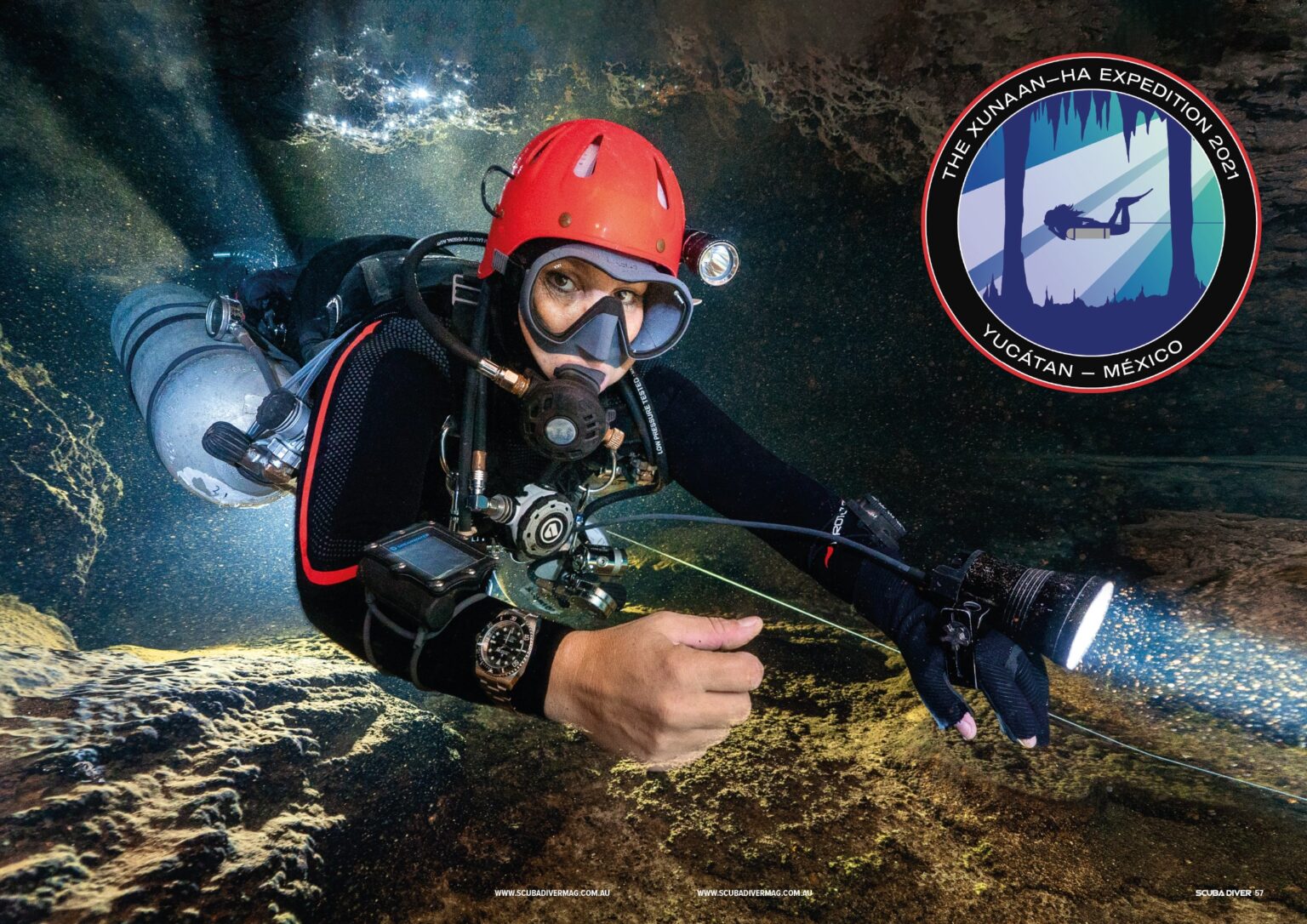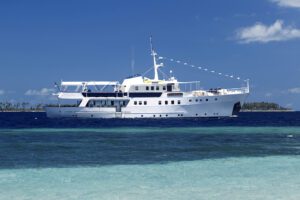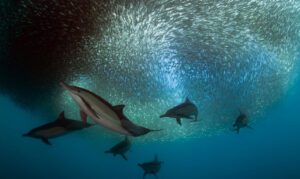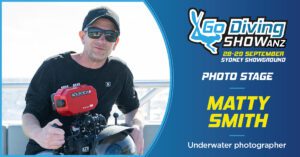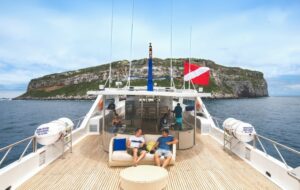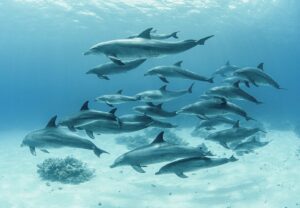In November 2021, Maria Bollerup was part of the dive team on the Xunaan-Ha Expedition, a cave exploration project in the Mexican jungle. It has taken her months to share the recollection of the events in writing, and in some ways, she thinks she is still coming down from what turned out to be a life- and careerchanging event.
Photographs by Tom St George, Evan Whitney and Richie Schmitter.
The Xunaan-Ha Expedition was, as were so many other events, struck by COVID-19 and postponed twice. The delay was a personal challenge, because I come from Denmark, where there are no caves for keeping my skills sharp. After spending two years confined in Denmark, I was to be tossed right into some of the most-demanding diving imaginable. During the project, we were going to dive caves that had never been explored before. I have been fortunate to do so before, but never with an objective that reached beyond my own ego and lust for adventure. This time, there would be outside expectations, scientific objectives, and actual goals to be reached.
You see, the expedition was not just about uncovering more cave under the jungle. Professional cave explorers in the area are constantly exploring and uncovering the intricate flooded cave systems – and I salute them. This is hard and dirty work, and extremely exciting to be part of! The Xunaan-Ha Expedition, however, had a higher goal – aquifer conservation – which is considered so important.
For most divers, the Yucatan Peninsula is on the list of places to dive because of the spectacular and world famous cenotes. While most divers stay in the light zone of the cenotes, or sinkholes, others extend their training to experience full cave diving, following marked lines into the pitch-black tunnels underneath the jungle. Only a very small handful of divers are so privileged, skilled and connected with the local community, that they do exploratory diving in the caves. Robbie Schmittner is one of these people. It is safe to say that this man is a legend within cave exploration.
For the past 20 years, Robbie Schmittner has been trekking through the jungle with a machete, dining at bonfires and sleeping in hammocks while looking for cenotes and caves to explore. In total, he has laid more than 400km of line in these caves. I encourage you to give that number an extra thought… He is responsible for connecting Dos Ojos and Sac Aktun, which is to date the longest water-filled cave in the world, running 369km.
During his years of exploration, Robbie developed an interesting thesis, which he can best explain himself. The summary I’m presenting now is merely the essence.
In short, Robbie believes that the flow of water is running south to north along the coast, and that the ridges from the crater of Chicxulub, along with fractures running parallel to the coastline, are carrying pollutants from all over the peninsula and into the ocean. The bottom line, he says – everything is connected. Working to save the eco-systems in the ocean and the mangroves along the coast is merely a bandage on the bleeding wound that is the whole peninsula. Visualize farms, hotels and villages pouring wastewater right into the aquifer that is sitting just beneath the surface, which then flows through the land, mangroves and into the ocean.
For more in-depth knowledge, I recommend you read his article, Large-scale groundwater movements in the Yucatan Peninsula, which Robbie wrote together with his colleague, the archaeologist Dante García, which has been published in the scientific journal AvaCient from the Tecnológico Nacional de México.
The Xunaan-Ha expedition was created and received the support it did because of the immediate need for protection of this unique freshwater reservoir; the Yucatan Aquifer. It is a known fact that freshwater will become scarce in the future, and that our oceans are suffering now.
In the Yucatan Peninsula, there is a unique opportunity to get to the root of the problem. And The Xunaan-Ha Expedition has started the ‘weeding work’. I will leave the scientific details to Robbie Schmittner – you can find out much more in his report.
Preparing for the expedition
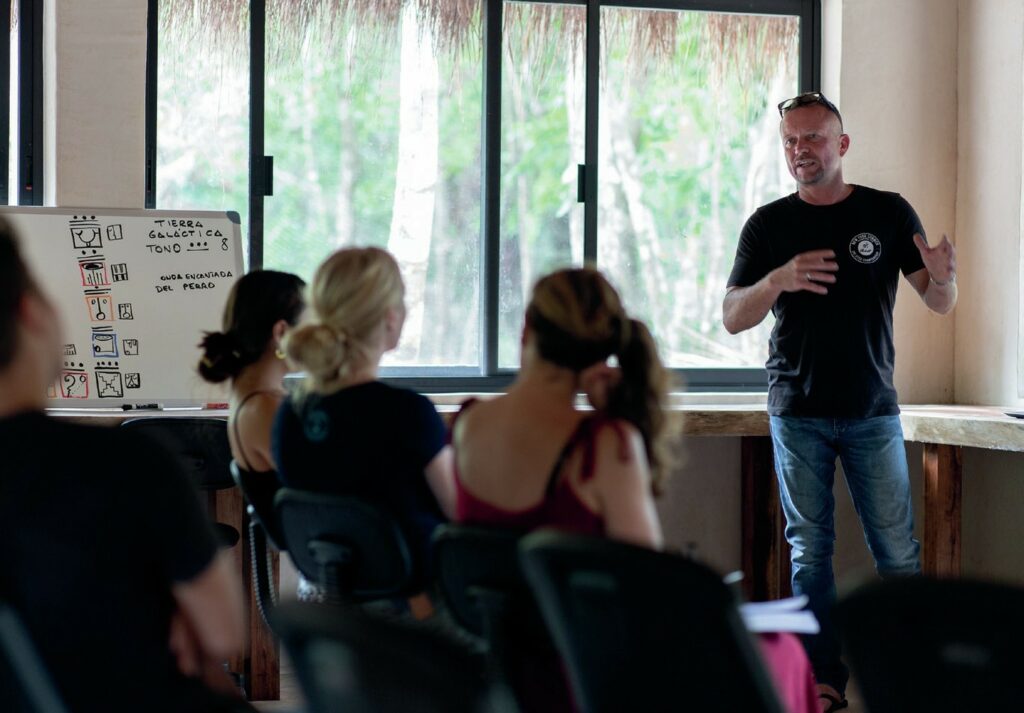
Instead… let me tell you how it feels to be a mere mortal cave diver and take part in something this important and big.
In the weeks approaching the project, the contact between the team divers and Robbie intensified. As the expedition leader, Robbie kept us somewhat in the dark about where we were going (other than ‘into the jungle somewhere’), and what we’d be doing (besides ‘diving in unexplored caves’). You might wonder why we agreed to join him, more or less blindfolded, up until the point of arrival, but everyone on the team has known Robbie for years, and when he invites you into the jungle, you’d be stupid to decline. Besides, it’s not uncommon that the ‘what, where and when’ is a little hush-hush when it comes to exploration in Mexico. Robbie was making sure that where we were going was kept a secret.
A week prior to the official start of the project, the team divers decided to meet up in Tulum to take some time to dive together and get synchronized – literally. We are all experienced cave divers, but our experience and training differs. We needed to make sure that we agreed on how to lay and mark the lines in the caves we were about to dive. These lines would literally become our lifelines, and navigational confusion can have a fatal outcome.
Out of the six team divers, I knew only Rannva Joermundsson. She’s a long-time friend and cave diving buddy from the Faroe Islands. We know each other’s strengths and weaknesses, and she’s an extremely frank and honest person.
Honesty creates trust, and you want to trust that your buddy is being honest about how he or she is feeling prior to and during the kind of dives we were about to do. Fatigue, anxiety and anything in between can lead to panic, and that’s one emotion you truly want to avoid in cave diving, not to mention exploration cave diving!
It was during these pre-expedition days I came to know the rest of the team. They deserve an article each, but here is a quick introduction:
Rannva Joermundsson | Faroe Islands
Works at Fourth Element and represents Shearwater in Scandinavia and the Baltics. Has been diving for 14 years, is a CCR cave diver and is the kind of person to lift the mood of an entire company. She’s my favourite buddy, a great diver and the most wonderful, hard-working, no-bullshit person.
Julia Gugelmeier | Germany
Works in cave diving in Mexico. She’s been diving for 18 years and logged more dives than it’s worth counting. Julia is the personification of calm. She’s got the orderly, stern sense of every German (ordnung muss sein), and calm like you wouldn’t believe. If I were ever to be critically stuck inside a cave, I would want Julia with me. She’d get us out.
Melodie Trevino | Mexico
Bad-ass incarnated. She’s a determined, super-smart woman who throws in a great sense of humour along with her wit. Melodie runs her two dive centres XTC in Mexico and is coping with cave and ocean divers on a daily basis. She cares deeply for the environment and the Yucatan Aquifer. Needless to say that her heart was fully engaged for this project. She’s a CCR cave diver and an excellent bonfire chef!
Ellen Cuylaerts | Belgium
Ellen is an Emmy-award-winning wildlife photographer, and mother of two (now adult) kids. She has a presence of positive determination – you rightfully earn this mindset if you are used to being helicopter-dropped onto an iceberg in the Arctic, to lay still for hours, capturing harp seals with your lens). Ellen is a Belgian powerhouse of a no-nonsense, no-whining, get-the-job-done woman. She waded through waist-deep swamp water on a daily basis to do three- to four-hour long dives. She’s a lupus warrior with an allergy to mosquitos and I witnessed her body swell up, without a single whimper from her. I admire her.
Tamara Lelani May | Half-Australian, half-Papua New Guinean
Tamara works in cave diving and has been diving for 12 years. She is one of those divers you wouldn’t know was there, until she blinks. She’s known as Ninja (Dive like a Ninja), and she is (most likely) the most stealthy diver in existence (don’t be offended, I’m sure you look pretty good in the water too). Being a Thai boxer, Tamara was probably the most beast-minded diver on the team.
Doing the longest dives in the nastiest of places. In another world, she’d be a hardcore Amazonian warrior.
Maria Bollerup | Denmark
The past 20-plus years of my life have been completely dedicated to the diving industry. I became a professional at 18, and technical diving/cave diving is my constant gravitational point. My strength is my enthusiasm, or let’s call it ‘obsession’. It has led me to dive all over the world, nursing my diving companies and my passion for adventure. So you see, we were all a determined little bunch that got picked for the job. And the truth be told, we worked splendidly as a team. Everyone understood the importance of the project, everyone worked to lift each other up. Afterwards, when I get questions about the experience, most ask: “What was it like, being an ‘all-female’ team”.
First, many female divers dive together in a team, or in mixed teams. At this level of diving, your skills are the winning factor, not your gender. So yes… It was great. No whining, no showing off, just a collected, synchronized team that had the same goal: “Get the job done -well”. And all were capable of doing so.
The Rest of The Team
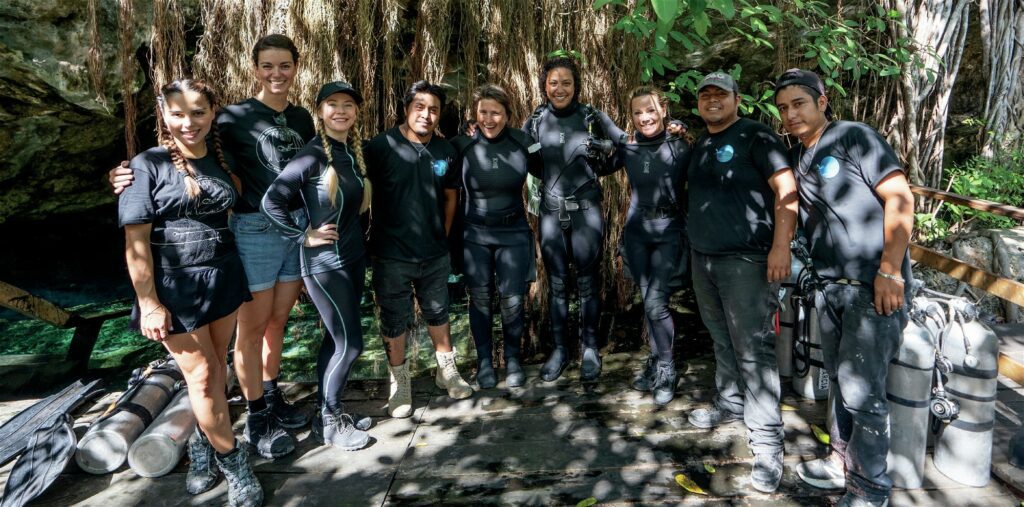
Project manager: Robbie Schmittner
UW photographers: Tom St George & Richie Schmittner
Topside photographer: Evan Whitney
Underwater videographer: Maru Brito
Underwater light: Gabriel Gasca Rubi
Topside videographer: Paris Palacios
Topside audio: Felipe Rayo
Director: Scott Carnahan
Assistant director: Ana Overgaard
Dailies and runner: Ember Roth
Porters: Arturo, Gustavo, Jesus and Marlon
Into Mexico
Now the team was finally gathered in Mexico. We had taken the time to get to know each other and streamline our linework. Robbie and the rest of the crew invited everyone to meet the first morning of the project for a briefing.
I knew there’d be someone to document our work, but I counted 22 people that morning – six team divers and the rest were porters, videographers, sound guy, light guy, underwater light guy, underwater video woman, underwater camera people, etc. (See the Fact Box listing the full team and their names for your reference). At this point, I started sweating, and it was not because of the Mexican heat. The scale of the project was dawning on me.
Shortly after meeting the entire team, we were taken to a location where Robbie did an hour-long presentation on his thesis, sharing with us what he believed was happening, and what should and could be done. And quite relevantly, why we were doing what we were about to go do.
Before we would start the journey to where we’d be working, Robbie ran a survey workshop. Armed with compasses on a slate, we learned to correctly survey the lines we’d be installing during the project. If you measure 1 degree off on the compass, take a wrong depth reading or count the knots wrong (before the dive, you tie a knot on the line every ten feet), your cave survey will be off.
Precision is important. But so are gas management, environmental awareness, orientation, buddy contact, position, trim, buoyancy, fin technique, etc. In all fairness, this should come naturally to anyone doing this kind of diving.
Cave exploration in its full form is task loading. Full stop. Then add the mental pressure of an ‘official expedition’. I think I can speak for the entire team when I say we enjoyed ourselves, but we also took the task very seriously.
NB: Join Maria and the team next issue as the Xunaan-Ha Expedition gets underway.
ROLEX Perpetual Planet Initiative
For nearly a century, Rolex has supported pioneering explorers, pushing back the boundaries of human endeavor. With the Perpetual Planet initiative, launched in 2019, Rolex is committed for the long term to support the explorers in their quest to protect the environment. Learn more about the Xunaan-Ha expedition.

This article was originally published in Scuba Diver ANZ #57.
Subscribe digitally and read more great stories like this from anywhere in the world in a mobile-friendly format. Link to the article.
